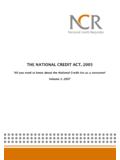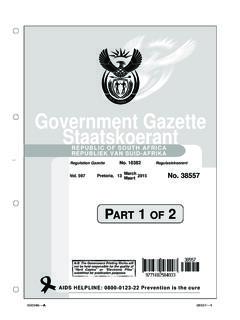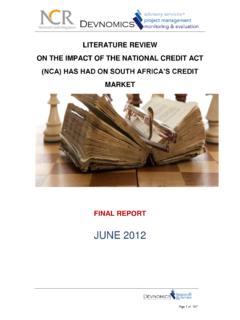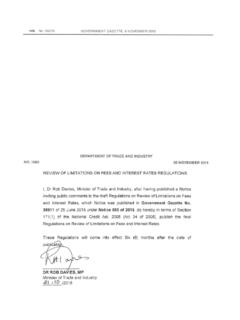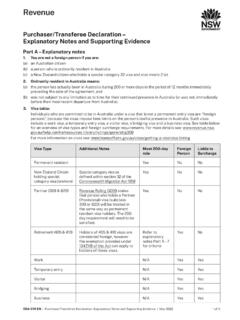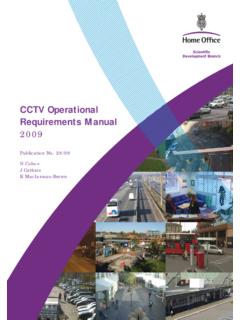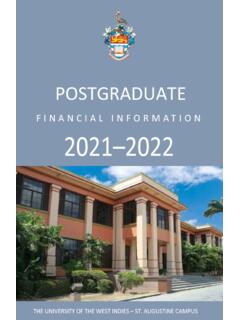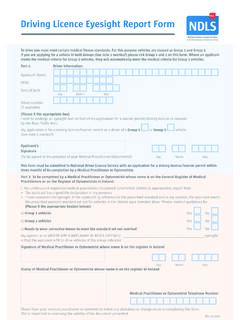Transcription of EXPLANATORY NOTE TO THE WITHDRAWAL GUIDELINES
1 INTRODUCTION On 19 February 2015, the National Credit Regulator ( the NCR ) issued GUIDELINES 002/2015 for the WITHDRAWAL from Debt Review. Subsequently, challenges were experienced by the industry regarding the implementation of certain aspects of the GUIDELINES . As a result, the sub-committee that dealt with the matter reconvened to find ways to address the identified implementation challenges. PURPOSEThis EXPLANATORY note is intended to clarify application of all the aspects covered in the GUIDELINES 002/2015 for the WITHDRAWAL from Debt NOTES1. WHEN CAN A CONSUMER EXIT DEBT REVIEW PROCESS? Section 71 of the National Credit Act 34 of 2005 as amended ( the Act ), states the following:Section 71: Removal of record of debt adjustment or judgment(1) A consumer whose debts have been re-arranged in terms of Part D of this Chapter must be issued with a Clearance Certificate by a Debt Counsellor within seven days after the Consumer has (a) Satisfied all the obligations under every credit agreement that was subject to that debt re-arrangement order or agreement in accordance with that order or arrangement; or(b) Demonstrated (i) Financial ability to satisfy the future obligations in terms of the re-arrangement order or agreement under (aa) a mortgage agreement which secures a credit agreement for the purchase or improvement of immovable property.
2 Or (bb) any long-term agreement as may be prescribed; (ii) That there are no arrears on the re-arranged agreements contemplated in subparagraph (i); and (iii) That all obligations under every credit agreement included in the re-arrangement order or agreement other than those contemplated in subparagraph (i) have been settled in fullTherefore, a consumer under debt review can only be issued with a clearance certificate when one of the following has happened:(a) s/he has either paid up all his/her debts which were listed in the debt review Court Order or debt review repayment agreement; OR(b) when all his/her short-term credit agreements listed in the debt review Court Order or debt review repayment agreement which short-term credit agreements include a vehicle financing agreement have been paid up in full AND the consumer is only left with a mortgage loan which is not in arrears in terms of the debt review Court Order or debt review repayment agreement.
3 1 EXPLANATORY NOTE TO THE WITHDRAWAL GUIDELINES22. CAN A DEBT COUNSELLOR TERMINATE OR WITHDRAW THE DEBT REVIEW PROCESS?NO The debt counsellor does not have statutory powers to terminate or withdraw the debt review is not valid and may no longer be used after 19 February 2015. The update of Debt Help System (DHS) with status code H ( WITHDRAWAL by a debt counsellor) is no longer allowed. The NCR is in the process of implementing new status codes aligned to the GUIDELINES and debt counsellors are advised not to update records with the status code note that the NCR has an internal process in place to assist consumers who withdrew from the debt review process prior to issuance of these GUIDELINES on 19 February 2015. For the NCR to assist, the Form must have been issued prior to 19 February 2015, proof of dispatch of same to each credit provider must be attached and the correct status code must have been updated on DHS as at the date of issue of Form 3.
4 CAN A CONSUMER WITHDRAW FROM THE DEBT REVIEW PROCESS AFTER A COURT ORDER HAS BEEN GRANTED?YES, however, this is applicable when a subsequent Court Order has been issued emanating from the following Court application: (a) An application for rescission of the granted debt review Court Order requesting that the consumer be declared no longer over-indebted at the Magistrates Court with the relevant jurisdiction.(b) This application for rescission must advise the Court that the consumer had been found over-indebted by the Magistrates Court and a copy of Court Order is to be attached as an annexure.(c) The application for rescission must advise the relevant Magistrates Court that the consumer is no longer over-indebted and must include the consumer s financial circumstances at that time in motivation of the aforesaid.
5 (d) The application for rescission must further advise the relevant Magistrates Court that the consumer no longer needs to be under debt receipt of the granted rescission Court Order the debt counsellor must:(a) Notify all the credit providers of same by means of the Form and attach a copy of the granted rescission Court Order;(b) Remove the consumer s debt review flag on the credit bureaux by updating DHS with the relevant status code. Currently the applicable status code remains G ( WITHDRAWAL by the consumer).Your attention is drawn to the following: The consumer is responsible for the full cost of this rescission application. Where the consumers are married in community of property and completed a joint application for debt review OR the consumers have elected to voluntarily apply jointly for debt review ( co-signatories to a mortgage bond, etc.)
6 , the consumers will have to submit a joint application for rescission of the debt review Court Order. It is only once all the steps which culminate in the issuing of the Form have been successfully completed, that compliance with the WITHDRAWAL GUIDELINES can be said to have taken CAN A CONSUMER WITHDRAW OR TERMINATE THE DEBT REVIEW PROCESS PRIOR TO OBTAINING A DEBT REVIEW COURT ORDER?YES, however, this is applicable in the following Prior to declaration of over-indebtedness A consumer can withdraw or terminate the debt review process prior to the declaration of over-indebtedness and issuance of Form to the credit providers. The debt counsellor must issue a Form A and update DHS. Currently the applicable status code remains G ( WITHDRAWAL by the consumer). Post declaration of over-indebtedness The debt counsellor has the statutory power to recommend that the consumer be declared over-indebted, however, the Magistrates Court in terms of Section 85(b), Section 87(1) and/or Section 88(1)(b) of the Act has powers to declare the consumer over-indebted or not over-indebted.
7 If the debt counsellor has recommended that the consumer be declared over-indebted and the Form has been issued to credit providers, the consumer must approach the Magistrates Court with the relevant jurisdiction to be declared not over-indebted and no longer under debt review. 3 A court application in terms of Section 87(1)(a) of the Act must be made to the Magistrates Court with relevant jurisdiction requesting the Court to reject the debt counsellor s recommendation that the consumer be found over-indebted; and declare the consumer no longer over-indebted. The application must advise the Court that the consumer had been found over-indebted by the debt counsellor and a copy of the Form is to be attached as an annexure. The application must advise the relevant Magistrates Court that the consumer is no longer over-indebted and must include the consumer s financial circumstances at that time in motivation of the aforesaid.
8 The application must further advise the relevant Magistrates Court that the consumer no longer needs to be under debt attention is drawn to the following: The consumer is responsible for the full cost of this application; Where the consumers are married in community of property and completed a joint application for debt review OR the consumers have elected to voluntarily apply jointly for debt review ( co-signatories to a mortgage bond, etc.), the consumers will have to submit a joint application. It is only once all the steps which culminate in the issuing of the Form have been successfully completed, that compliance with the WITHDRAWAL GUIDELINES can be said to have taken receipt of the Court Order the debt counsellor must: (a) Notify all the credit providers of same by means of the Form and attach a copy of the granted Court Order; (b) Remove the consumer s debt review flag on the credit bureaux by updating DHS with the relevant status code.
9 Currently the applicable status code remains status G ( WITHDRAWAL by the consumer).5. CAN A DEBT COUNSELLOR SUSPEND HIS/HER SERVICE FROM A CONSUMER UNDER THE DEBT REVIEW PROCESS?YES, however, this is applicable in the following circumstance: Where a consumer is not cooperating with the debt counsellor, a debt counsellor can suspend provision of his/her service to the consumer. Election by consumers to make direct payments to credit providers cannot be construed as non-cooperation and should not be used as a reason for suspension of debt counselling services. Prior to suspension of the service, a debt counsellor must notify the consumer of the intended suspension of service, the consequences thereof and allow the consumer TEN (10) business days to remedy the situation. The notice of suspension should include the following information: - Notice of pending service suspension and the reasons for suspension; - Consequences of non-cooperation; - Option to remedy the situation within TEN (10) working days; - If no response is received and the situation has not changed, consumers and credit providers should be notified of the suspension of service by means of a Form The debt counsellor remains the debt counsellor on record for the consumer and is responsible for the issuance of a Form should the consumer wish to transfer to another debt CAN A CONSUMER BE TRANSFERRED TO ANOTHER DEBT COUNSELLOR?
10 YES, at any stage in the debt review process. The 60 business day period referred to in Section 86(10) does not start afresh upon the successful transfer of the consumer to the new debt counsellor. The consumer s application continues as from the last step or action taken by the former debt counsellor. The new debt counsellor may not charge the consumer a new application fee. The process is facilitated by the compulsory procedure set out hereunder: Transfer of a single consumer The following documents must be provided to the NCR in order to process the transfer: A signed acknowledgement letter from the new debt counsellor; A signed Form from the previous DC consenting to the transfer; and A copy of the consumer s ID. Please note that a copy of the Form must also be sent to all relevant credit Transfer of consumers in bulk (all consumers on the DC profile)The following documents must be provided to the NCR in order to process the transfer: A consent letter signed by both debt counsellors (new and previous).
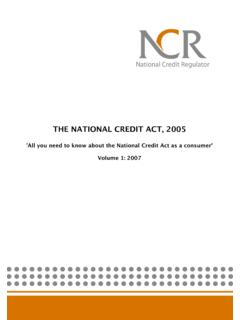
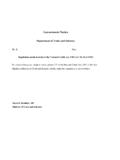
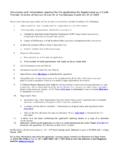
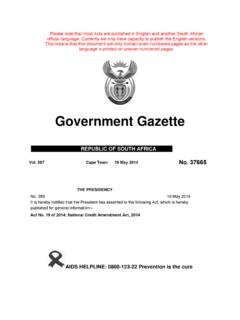
![National Credit Act [No. 34 of 2005] - ncr.org.za](/cache/preview/e/1/4/f/9/e/9/9/thumb-e14f9e9994b5110ac0b591f97627b092.jpg)
